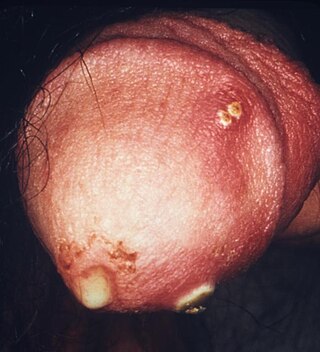
Sexual health clinics specialize in the prevention and treatment of sexually transmitted infections.

Sexual health clinics specialize in the prevention and treatment of sexually transmitted infections.
Sexual health clinics are also called sexually transmitted disease (STD) clinics, sexually transmitted infection (STI) clinics, venereal disease (VD) clinics, or genitourinary medicine (GUM) clinics.[ citation needed ]
Sexual health clinics differ from reproductive health and family planning clinics. Sexual health clinics offer only some reproductive health services. Reproductive health clinics, such as Planned Parenthood, offer most of the services of sexual health clinics.[ citation needed ]
Sexual health clinics provide some or all of the following:[ citation needed ]
Many clinics provide vaccinations to prevent infections from the hepatitis A and B viruses. [1] Young women may receive vaccinations to prevent infection from some strains of the human papillomavirus (HPV).[ citation needed ]
Many clinics provide interpreting for the hearing impaired or speakers of other languages.[ citation needed ]
Many clinics will help patients tell their sexual contacts if they have a sexually transmitted infection, anonymously if needed. [2]
Public governmental and non-profit clinics often provide services for free or adjust the fee based on a patient's ability to pay. Sexual health clinics often offer services without appointments. Some clinics open evenings or weekends. Some clinics have separate hours or facilities for men and women. Some clinics serve only specific populations such as women, men, MSM, youths, LGBT, ethnic groups, the poor, or students.[ citation needed ]
With the patient's consent, a clinician will inspect the patient visually and by touch. If needed, the clinician will take samples to test for sexually transmitted infections.[ citation needed ]
In a private room or space, the patient will partially undress.[ citation needed ]
The clinician may inspect the patient's:[ citation needed ]
The clinician may swab the patient's:
The clinician may take small blood samples by pricking a finger or from a vein [4] to test for HIV, syphilis, and possibly herpes [5] and hepatitis C. [6] [7] [8]
The clinician may ask for a small urine sample, given in private, to test for chlamydia and possibly gonorrhea. The inspections and taking samples do not hurt, but swabbing the urethra and cervix, and a finger prick blood sample feel uncomfortable. Women will often receive a pelvic exam, both external and internal, but usually less thorough than a reproductive health exam. A patient can choose a female or male clinician if available. A patient can have a chaperone. Some clinics have separate hours or facilities for men and women.[ citation needed ]
Medical confidentiality is an important part of the medical ethics of a doctor–patient relationship. Sexual health clinics follow local standards of medical confidentiality to protect the privacy of patients. Some clinics provide anonymous services or protect confidentiality by having a patient use a number or a pseudonym. [9]
Additional privacy protections sometimes apply to matters of sexuality and reproduction, since these areas are sensitive in many cultures. The diagnosis of HIV/AIDS has legal restrictions in patient confidentiality, and some clinics use rapid antibody tests to provide results to a patient within 30 minutes, without holding the patient's records.[ citation needed ]
In the United States, clinics receiving federal funding from Medicaid or Title X of the Public Health Service Act must treat all patients confidentially. Thus minors can receive services without parental notification or consent. [10] [11] [12] Additionally, medical records for all patients age 18 and above are strictly confidential under HIPAA. [13]
Medical standards of informed consent apply to sexual health clinics. A patient needs information about the purposes and consequences of examinations, tests, treatments, and other procedures. A patient may then choose whether to consent to these procedures.[ citation needed ]
A minor may consent to receive some or all of the procedures at many sexual health clinics.[ citation needed ]

Chlamydia, or more specifically a chlamydia infection, is a sexually transmitted infection caused by the bacterium Chlamydia trachomatis. Most people who are infected have no symptoms. When symptoms do appear they may occur only several weeks after infection; the incubation period between exposure and being able to infect others is thought to be on the order of two to six weeks. Symptoms in women may include vaginal discharge or burning with urination. Symptoms in men may include discharge from the penis, burning with urination, or pain and swelling of one or both testicles. The infection can spread to the upper genital tract in women, causing pelvic inflammatory disease, which may result in future infertility or ectopic pregnancy.

Pelvic inflammatory disease, also known as pelvic inflammatory disorder (PID), is an infection of the upper part of the female reproductive system, namely the uterus, fallopian tubes, and ovaries, and inside of the pelvis. Often, there may be no symptoms. Signs and symptoms, when present, may include lower abdominal pain, vaginal discharge, fever, burning with urination, pain with sex, bleeding after sex, or irregular menstruation. Untreated PID can result in long-term complications including infertility, ectopic pregnancy, chronic pelvic pain, and cancer.

Safe sex is sexual activity using methods or contraceptive devices to reduce the risk of transmitting or acquiring sexually transmitted infections (STIs), especially HIV. "Safe sex" is also sometimes referred to as safer sex or protected sex to indicate that some safe sex practices do not eliminate STI risks. It is also sometimes used colloquially to describe methods aimed at preventing pregnancy that may or may not also lower STI risks.

Cervicitis is inflammation of the uterine cervix. Cervicitis in women has many features in common with urethritis in men and many cases are caused by sexually transmitted infections. Non-infectious causes of cervicitis can include intrauterine devices, contraceptive diaphragms, and allergic reactions to spermicides or latex condoms. Cervicitis affects over half of all women during their adult life.

A vertically transmitted infection is an infection caused by pathogenic bacteria or viruses that use mother-to-child transmission, that is, transmission directly from the mother to an embryo, fetus, or baby during pregnancy or childbirth. It can occur when the mother has a pre-existing disease or becomes infected during pregnancy. Nutritional deficiencies may exacerbate the risks of perinatal infections. Vertical transmission is important for the mathematical modelling of infectious diseases, especially for diseases of animals with large litter sizes, as it causes a wave of new infectious individuals.
Serosorting, also known as serodiscrimination, is the practice of using HIV status as a decision-making point in choosing sexual behavior. The term is used to describe the behavior of a person who chooses a sexual partner assumed to be of the same HIV serostatus in order to engage in unprotected sex with them for a reduced risk of acquiring or transmitting HIV/AIDS.

The Berkeley Free Clinic is a non-profit community clinic located in Berkeley, California, US. It is operated as a worker-run collective by more than 100 volunteers. It has provided free medical care since opening in 1969.

Genital herpes is a herpes infection of the genitals caused by the herpes simplex virus (HSV). Most people either have no or mild symptoms and thus do not know they are infected. When symptoms do occur, they typically include small blisters that break open to form painful ulcers. Flu-like symptoms, such as fever, aching, or swollen lymph nodes, may also occur. Onset is typically around 4 days after exposure with symptoms lasting up to 4 weeks. Once infected further outbreaks may occur but are generally milder.

Reproductive medicine is a branch of medicine concerning the male and female reproductive systems. It encompasses a variety of reproductive conditions, their prevention and assessment, as well as their subsequent treatment and prognosis.
Venereology is a branch of medicine that is concerned with the study and treatment of sexually transmitted diseases (STDs). The name derives from Roman goddess Venus, associated with love, beauty and fertility. A physician specializing in venereology is called a venereologist. In many areas of the world, the specialty is usually combined with dermatology.
The American Sexual Health Association (ASHA), formally known as the American Social Hygiene Association and the American Social Health Association, is an American nonprofit organization established in 1914, that cites a mission to improve the health of individuals, families, and communities, with an emphasis on sexual health, as well as a focus on preventing sexually transmitted infections and their harmful consequences. ASHA uses tools such as education, communication, advocacy and policy analysis activities with the intent to heighten public, patient, provider, policymaker and media awareness of STI prevention, screening, diagnosis and treatment strategies.

Gonorrhoea or gonorrhea, colloquially known as the clap, is a sexually transmitted infection (STI) caused by the bacterium Neisseria gonorrhoeae. Infection may involve the genitals, mouth, or rectum. Infected men may experience pain or burning with urination, discharge from the penis, or testicular pain. Infected women may experience burning with urination, vaginal discharge, vaginal bleeding between periods, or pelvic pain. Complications in women include pelvic inflammatory disease and in men include inflammation of the epididymis. Many of those infected, however, have no symptoms. If untreated, gonorrhea can spread to joints or heart valves.

A sexually transmitted infection (STI), also referred to as a sexually transmitted disease (STD) and the older term venereal disease (VD), is an infection that is spread by sexual activity, especially vaginal intercourse, anal sex, oral sex, or sometimes manual sex. STIs often do not initially cause symptoms, which results in a risk of passing the infection on to others. Symptoms and signs of STIs may include vaginal discharge, penile discharge, ulcers on or around the genitals, and pelvic pain. Some STIs can cause infertility.
Sexually transmitted infections in the pornography industry deals with the occupational safety and health hazard of contracting sexually transmitted infections (STIs) by workers in the sex industry. Since the 1980s many cases of pornographic performers contracting HIV/AIDS have been reported. However, since the mid 2000s strict adherence to rigorous STI testing, and limiting sexual contact with only fellow tested performers has halted the spread of HIV and other STIs in the industry.
Partner services is a public health term which refers to the health intervention given to a client's intimate partners when a client goes to a health care provider requesting health care.
Partner notification is the practice of notifying the sexual partners of a person, known as the "index case", who has been newly diagnosed with a sexually transmitted infection that they may have been exposed to the infection. It is a kind of contact tracing and is considered a partner service.
Infectious diseases within American correctional settings are a concern within the public health sector. The corrections population is susceptible to infectious diseases through exposure to blood and other bodily fluids, drug injection, poor health care, prison overcrowding, demographics, security issues, lack of community support for rehabilitation programs, and high-risk behaviors. The spread of infectious diseases, such as HIV and other sexually transmitted diseases, hepatitis C (HCV), hepatitis B (HBV), and tuberculosis, result largely from needle-sharing, drug use, and consensual and non-consensual sex among prisoners. HIV and hepatitis C need specific attention because of the specific public health concerns and issues they raise.

Suraksha Clinic are a chain of STI/RTI Clinics. These clinics are established by National AIDS Control Organisation for the better health services and for the prevention of HIV/AIDS in India.

Penile discharge is fluid that comes from the urethra at the end of the penis that is not urine, pre-ejaculate or semen.
Human sexual promiscuity is the practice of having many different sexual partners. In the case of men, this behavior of sexual nondiscrimination and hypersexuality is referred to as satyriasis, while in the case of women, this behavior is conventionally known as nymphomania. Both conditions are regarded as possibly compulsive and pathological qualities, closely related to hyper-sexuality. The results of, or costs associated with, these behaviors are the effects of human sexual promiscuity.
Notify everyone you've had sex with in the past six months.
Show Your ID
Find a Testing Site Near You
Find a Health Center
Search for a health center near you
Find a STD Care Location Near You
GUM Clinic
Find your nearest clinic
sexual health clinic
Find your nearest clinic
Find your nearest STI clinic
Contraception and Sexual Health Clinics(Wales)